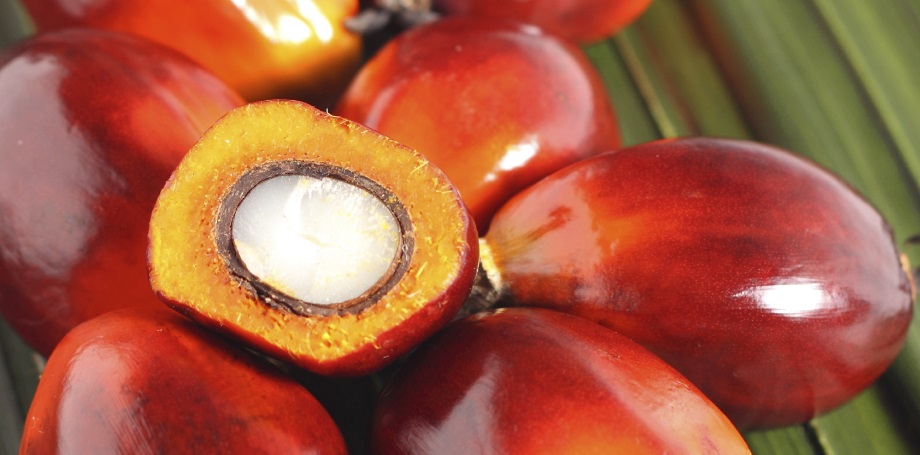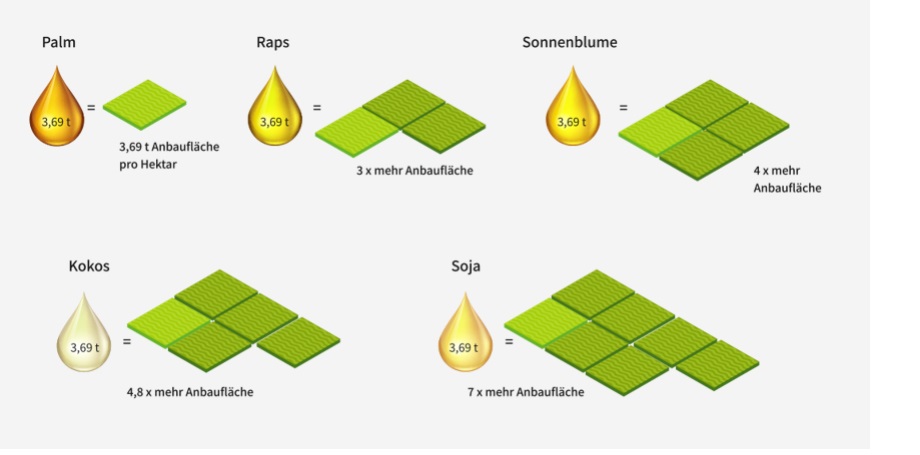The challenge of a natural oil
11
Sep

Palm oil is once again coming under heavy criticism. The most widely used oil in the world, palm oil is present in all kinds of consumer products – from margarine to ready-made foods, candy, cosmetics, and detergents. But what makes palm oil so appealing for use in cosmetics? Should we be looking for alternatives to meet the ceaselessly growing global demand for oils, or is it enough to pay careful attention to the origin of the palm oil we use?
The main cause for criticism of palm oil is the extensive clearing of tropical rainforests and thus the destruction of living habitats of countless species, all for the sake of new palm oil plantations to meet rising global demand. Slash-and-burn and drainage practices for clearing peat forests release large amounts of greenhouse gases such as carbon monoxide and methane. Furthermore, creating new plantations is often a source of social conflict due to land disputes.
Versatile, high-yield, low-cost
A 2017 German study on palm oil shows that more than half of all palm oil produced is consumed in the energy sector (around 52%). Another 22% is used in the food industry. This is followed by the animal feed industry and other chemical/pharmaceutical use. The washing, care, cleaning and cosmetics industries make up the rest at just under 3% percent. Since 2015, Germany-wide consumption of palm oil has grown by around 7% (1).
Thus, it appears palm oil has become a staple of today’s society and it is hard to imagine we will ever do without it again. For the harvest year 2018/19, the USDA predicts a global palm oil consumption of 68.65 million tonnes (2).
This boom has its reasons: the perennial oil palm is a very high yielding plant that can be harvested all year round. Additionally, oil palms can produce much more oil on the same land area than other oil plants. Rapeseed oil, for example, requires two to three times the amount of land for the same amount of oil.

Its high yield compared to other oil plants makes the oil palm a resource-saving and lucrative solution. As a consequence, however, new plantations areas are being cleared not only in Indonesia or Malaysia, but also in other tropical countries like Columbia, Nigeria, and Papua New Guinea. All of these countries want to profit from the palm oil boom, but often at the expense of nature and people.
But what makes palm kernel oil so appealing for use in cosmetics?
The oils from the oil palm are distinguished into palm oil and palm kernel oil. Palm oil is obtained from the fruit flesh, while palm kernel oil is obtained from the seed of the fruit. The two oils have different carbon chain distributions, which give rise to different properties in the end product.
While palm oil is mainly used in the food industry, palm kernel oil is mainly used in the cosmetics industry.
Compared to other vegetable oils, palm kernel oil has a high content of C12 and a moderate proportion of C14 and C18 carbon chains. This C-chain distribution lends palm kernel oil excellent chemical properties for cosmetic products: while medium chains produce foaming effects, the short chains are perfect for moisturizing and smoothing effects (3).
Cosmetics producers often do not use palm (kernel) oil directly, but rather in the form of derivatives such as glyceryl, sucrose, or ascorbyl palmitates. These are used in the formulation as natural emulsifiers, texturizers, and stabilizers.
All of these aspects and properties make palm (kernel) oil an attractive renewable vegetable oil, not only for the cosmetics industry.
How can we keep pace with rising demand and yet still protect the environment and rights of local communities? Should palm oil be replaced with other vegetable oils?
Sustainability as a guide
The WWF recommends employing exclusively sustainable palm (kernel) oil from controlled cultivation (4). According to the 3-pillar model, sustainability is based not only on ecological, but also on economic and social concerns.

As mentioned above, the oil palm delivers extremely high yields. To replace palm (kernel) oil, significantly larger tracts of land would have to be used for other oilseeds – with the corresponding negative impact on the environment. Ecologically and economically, the oil palm is thus the most sustainable solution to date. If the oil palm is also to be sustainable in social terms, the way in which it is produced must be taken into account.
One step forward in terms of sustainability is the certification process of the Roundtable on Sustainable Palm Oil (RSPO), established in 2004.
The Roundtable for Sustainable Palm Oil
The “Roundtable for Sustainable Palm Oil” (RSPO) is a not-for-profit organization that unites stakeholders from the 7 sectors of the palm oil industry: oil palm producers, processors and traders, consumer goods manufacturers, banks/investors, and environmental and social NGOs.
The RSPO has set itself the goal of reducing the irresponsible cultivation of oil palms and the associated environmental impacts, such as the destruction of living space by slash-and-burn and the emission of greenhouse gases.
To achieve this, the RSPO has developed a series of environmental and social criteria that companies must satisfy in order to produce certified, sustainable palm oil (CSPO) and palm kernel oil (CSPKO) (5).
Palm Oil Innovation Group – an extension of the RSPO
In addition to the RSPO certification system, a number of companies, including Greenpeace and the WWF, have joined forces in the “Palm Oil Innovation Group”.
The Palm Oil Innovation Group (POIG) focuses on
- Supporting the RSPO through building on RSPO standards and commitments, by demonstrating innovation in implementing existing RSPO standards as well as identifying additional critical issues.
- The three thematic areas of environmental responsibility, partnerships with communities including workers’ rights, and corporate and product integrity.
- Creating innovations in the palm oil industry and promoting these innovations (6).
“The Palm Oil Innovation Group makes it clear that they take the RSPO as a basis, but voluntarily apply additional requirements,” says Silvia Imken of Börlind. According to Imken, this is another step in the right direction, but the problem remains that large quantities of certified oil are never even purchased. “Only through a concerted and active effort in buying more certified oil, will it be possible to motivate producers to make further improvements,” Silvia Imken expressed in an interview with NaturkosmetikCamp.com (7).
Certification practices as progress
The topic of palm oil is highly complex and multi-layered, yet, despite the challenges mentioned, cultivation of the oil palm is not fundamentally bad.
As described above, switching to other oil plants is not an alternative due to their lower yield, and would only shift the problem elsewhere or even make things worse. Soy and coconut, for example, grow in the same or similarly ecologically sensitive regions, but more land is required to grow them. Europe’s most important vegetable oil, rapeseed oil, could not meet the growing global demand for vegetable oils. Considering the increasing world population and economic growth of consumer countries, good area efficiency is an important prerequisite for meeting the growing demand for vegetable oils.
Certifications like that of the RSPO and the support of small-scale farmers represent progress towards sustainability. In Indonesia, for example, hundreds of thousands of small-scale farmers live off the proceeds from oil plantations, and thus have the opportunity for better education and a measure of local prosperity.
By using certified palm (kernel) oil, cosmetics producers can contribute towards promoting environmentally and socially friendly methods in the growing regions.
Private consumers can contribute, too: not buying ready-made products, preferentially buying food, care and cleaning products that contain certified palm (kernel) oil, and adopting a conscious lifestyle will contribute to improving the situation in the palm oil sector.
Literature:
- w ww. forumpalmoel .org/imglib/Palmoelstudie%202017_Meo_FONAP_ho.pdf
- de .statista .com/statistik/daten/studie/443033/umfrage/konsum-von-palmoel-weltweit/
- www 1.basf .com/magazine/issue-7/article.the-palmoil-challenge.de.html
- www.wwf .ch/de/unsere-ziele/palmoel
- www. rspo .org/about
- poig. org/
- www.naturkosmetikcamp.com/2017/12/palmoel-naturkosmetik-herkunft-alternative-nachhaltigkeit-interview-silva-imken-boerlind/

Claudia Dür
Social Media Manager
Stories - Nature - Movement. These three words have the greatest meaning in my life.
As a passionate communicator, I am responsible for social media at IMPAG. In addition, I write various contents for our communication activities in the area of personal care. I love stories, constructive exchange, open discussions and teamwork. In my spare time you meet me and my family always in motion, be it biking, climbing and hiking in the mountains or surfing in the waves of the Atlantic.


Comments are disabled for this post.